Picture this: A team of 20 pumped-up engineers, fresh from their morning workout or playing with their kids, ready to code, and finish off their projects like a pro. They gather for a quick 15-minute Zoom meeting, and later get on with their day. But what was meant to be a swift update turns into a 90-minute marathon. The energy they brought from a fresh day now wanes as their update meeting loses agenda, gets clogged with unnecessary details, and a dev’s personal workday too gets derailed. Now they are exhausted, and struggle with switching context back to code. All because of one unproductive meeting!
Unproductive Meetings: The #5 Developer Productivity Killer


Reality-Check: Your developers struggle with more than 1 such unproductive meetings in a given work day.
Recently, Shopify cracked on its unproductive meetings after realizing the overhead cost borne by the organization. As per Shopify’s internal meeting calculator, the eCommerce giant loses $1600 weekly on a 30-minute meeting for 3 employees. For medium, and large engineering teams, imagine the operating cost for 100+ employees, and the financial burden it accompanies.
Software engineering demand is on rise, and every minute matters to deliver high-quality products to end users. Amidst this high-paced engineering, meetings need to evolve to be more than just a team gathering. They are a powerful, and shared platform to enroll team members, bring alignment, and foster collaboration.
Sadly, most engineering teams are still stuck with mundane, and unproductive meetings that distract devs more than empowering them.
The Cost of Unproductive Meetings
Did you know an average developer spends 23 hours a week in meetings, or 4-5 hours in a day and (surprise!), that doesn’t include the impromptu huddles, or Zoom calls. However, what’s worrying is 92% of the workforce considers these meetings unproductive, and costly. In another survey by Insider, everyday Americans conduct 11 million meetings. and that’s just the US alone. A third of them are unproductive, and can cost organizations upto $37 billion.
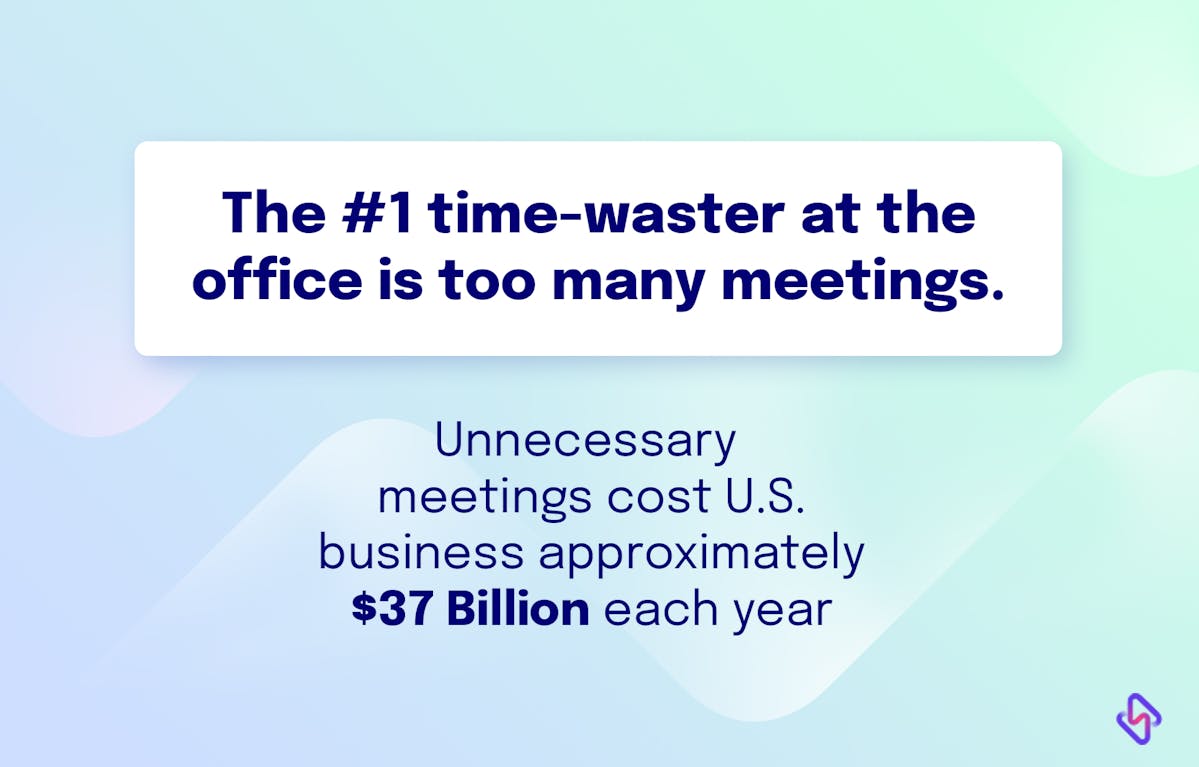
The total cost associated with these unproductive meetings is exorbitantly high for any engineering team, and yet mostly unaccounted for. Sadly, these unproductive meetings do not just impact organizations financially, but also cripple the overall developer productivity, and engineering efficiency.
Unproductive meetings take a toll on developers, zapping their productivity and leaving them frustrated. Time wasted in aimless discussions, without an agenda or highly digressed from pre-set agenda, means less time for coding, or grooming and that hits hard. Feeling disconnected and disengaged, developers struggle to find their coding groove. Their creative juices get stifled, and deadlines become a constant source of stress.
Moreover, a meeting overload shifts developers towards Zoom fatigue, and worse– technostress, and developer burnout. We all saw The Great Resignation growing before our eyes, and most engineers we surveyed candidly told us about why they quit. One of the major, but expected reasons– high meeting toll, and lack of focus hours. A known devil we have ignored for way too long.
Unproductive meetings have a high opportunity cost. When devs could have utilized the same workhours in brainstorming new ideas, networking, or completing their project checklist; they were stuck discussing off the charts topics, leading them nowhere. Besides, when meetings are unproductive, decisions are made haphazardly, leading to delayed projects, missed opportunities and lost revenue.
Now that we know how unproductive meetings affect engineering teams, let’s see what makes them ‘unproductive.’
4 Common Reasons Behind Unproductive Meetings
47% of the workforce considers “too many meetings” as a time-waster. Find out why.
1. Lack of Data-Driven Conversations
Data is the lifeblood of effective decision-making and team collaboration. Without access to real-time data, team discussions can lack the necessary context for understanding project deliveries, team velocity, and engineering bottlenecks. Lack of data-driven conversations directly translates to shallow and unfulfilling discussions, where teams fail at finding the root-causes, and rather delve into just status-updates. The pattern is not just limited to group meetings, but IC-EM 1:1s, and even conversations higher up the hierarchy between an EM and a DoE or a DoE and CTO for that matter.
Data-driven meetings focus more on recognizing trends and patterns that may bogging the team down– the cycle time is high, is it because of slow code reviews? Last week too had fluctuating lead times. Is it lack of automation, or the devs are stretched too thin?
Without data, teams only revolve around– our deliveries are late, and maybe we should freeup more time to code, with no clear plan in sight. Without data analytics, meetings, or 1:1s quickly devolve into subjective opinions, and guesswork, and not objective insights.
Presenting to the board of directors? Check out our guide to Board Meeting Slide Decks here!
2. ‘Too Long’ Meetings
A healthy team meeting should last for 15-20 minutes, and a weekly 1:1 should not take more than 45 minutes. However, the reality is different, and even alarming. Most team meetings stretch for over an hour, and some of them even extend to more than 90 minutes. Unless it is an all-hands of all business teams, or company-wide celebrations, 90-minutes can be a make or break for developer’s day.
Usually, over-stretched meetings create time constraints for developers, even leading to rushed work, or something working in off-hours to complete daily goals. Long meetings quickly turn unproductive because of no clear agenda, lack of a plan of action, interrupted engineering workflow, and broken engagement (remember the time you used your phone and turned off the camera).
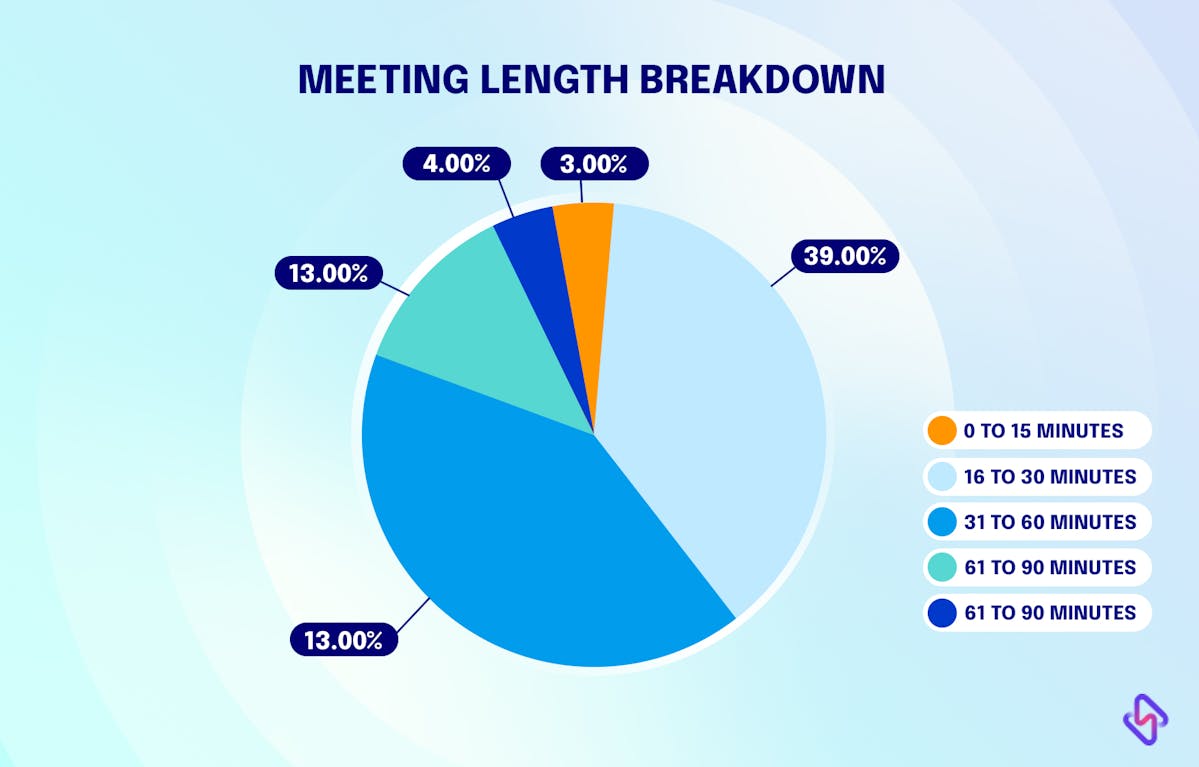
These long meetings are usually due to lack of data-driven conversations, zero to low visibility in engineering workflow, and no clear structure.
We discussed the former already, let’s talk about the latter.
3. Lack of Structured, and Planned Meetings
The most foundational issue with unproductive meetings is lack of agenda, structure, and planning. It’s more common for devs to go to meetings that we know nothing about than the ones we know. A clear structure keeps meetings organized, when they could have descended into chaos. No planning or structure often translates into meetings becoming presentations, limited participation, lack of focus, and a lot of wasted engineering hours.
Even when meetings seem productive initially, their impact can be negated without crisp, and effective follow-ups. Failing to document action items, responsibilities, and deadlines result in dragged discussions falling by the wayside, with no tangible outcomes.
4. More Status Updates, and Less Meaningful Discussions
Even now after so many conversations around developer productivity, still a lot of meetings start and end at: Can you update your work status? What have you done since last week? Instead of making the discussion more about identifying blockers, where the teams and individuals are actually stuck, figuring out internal/external dependencies we are stuck with mere status updates..
Even now, meetings are seen as a way to share retrospective information, rather than focusing on the future, or finding out about the ‘how’ of producing results. Engineering challenges require in-depth discussions around code reviews, best practices, technical standards, and project delivery. When meetings lack meaningful discussions, there is limited opportunity to address complex technical issues, potentially leading to unresolved problems and project bottlenecks.
Moreover, unproductivity creeps in when meetings become monotonous status updates. These types of meetings translate into inadequate knowledge sharing, a disconnect with the team, and missed innovation potential.
[ Read Related: Unlock True Meeting Management ]
How Unproductive Meetings Kill Developer Productivity?
One of our customers, an ed-tech platform, had a rigorous meeting schedule initially. However, as the team grew, so did the number of meetings on their weekly calendar. The meetings were timely run, and yet their volume impacted engineering workflows. Now more and more hours went to discuss immediate issues, while developer’s core tasks took a backseat.
They are not alone in their struggle with unproductive meetings. Find out for yourself how unproductive meetings wreak havoc on engineering teams:
1. Less Development Time For Engineers
As the user experience demonstrates, meetings, especially unproductive ones, force devs to trade-off their effective coding hours. Moreover, a lot of devs usually cope up with the issue by stealing from their personal time, or working out of office hours. No wonder, a developer only codes for 33% of their time. Writing even a few lines of code requires deep focus; but with too many meetings scheduled throughout the day, devs find it hard to concentrate.
Besides, most developers are introverts, and experience pre-meeting anxiety, especially if they are unsure about the meeting's agenda or their role in the discussion. This anxiety further aggregates into the "meeting recovery effect" where devs get so overwhelmed with meetings that they need time to mentally transition back to their primary tasks. Read more about how less coding time affects developer productivity.
2. Disrupted Flow State, and Maker Time
An engineer requires at least 30 minutes to get back into their ‘flow state’ and focus on writing code again. With meetings slated in different work halves- right from 10 am standups to 5pm catchup calls, developers struggle with their ‘deep work’ state– a prerequisite to write great code.
Ideally, developers have high maker time requirements- atleast one batch of 120-min time block reserved for high cognitive work requiring mental focus. However, with a fragmented schedule, developers have to find this quiet time on either weekends, or after-office hours. This often leads to a work-life imbalance, and unsustainable workload, making engineers anxious, and even burnout.
For more actionable tips on preserving high maker time and preventing burnout, check out our detailed guide on how deep work can solve the problem of burnout for developers.
3. Frequent Context Switching
Another issue that keeps devs on toes, and disrupts their flow is the context switching. Devs constantly switch context, both in, and after meetings. 92% multitask during meetings, from checking emails to working on other tasks.
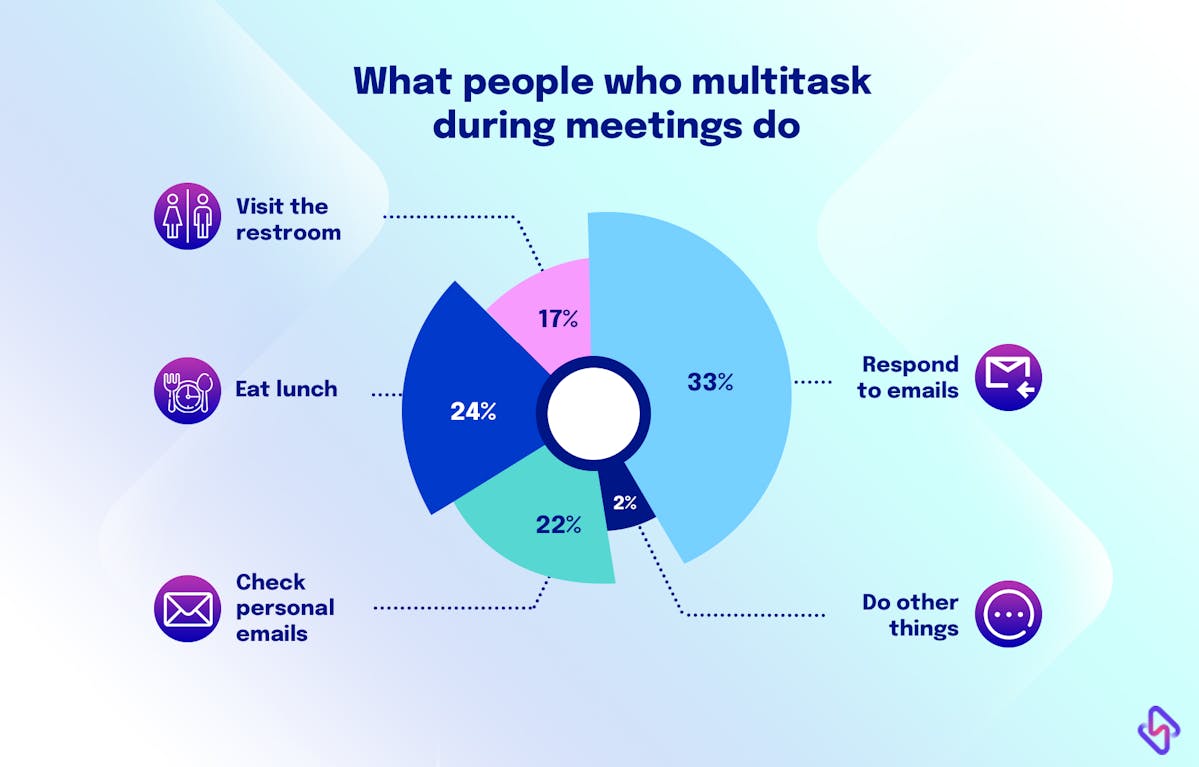
Further, 43% of devs accepted context switching as part of their fragmented workhours.
As dev attends around 8 meetings a week. Think about the extent of multitasking, and context switching done between them. This frequent context change often follows increased mental fatigue, higher error rates, lower code quality, and even negatively impacting creativity– all signs of low developer productivity and eventually poor output. Learn more about how context switching kills developer productivity.
4. Poor Developer Experience
Developer happiness too takes a hit with the rise of unproductive meetings.In a study at the University of North Carolina, Steven Rogelberg, the primary researcher wrote in great lengths about how an employee’s satisfaction is distorted with unproductive meetings. High screen time, and limited non-verbal cues are mentally taxing to most developers.
Moreover, Unproductive meetings can lead to a sense of frustration and disengagement among team members. Imagine dedicating time and effort to prepare for a meeting, only to find that it's disorganized, lacks focus, and leads nowhere. When employees repeatedly experience such scenarios, it can lower morale and dampen enthusiasm for future projects. A disheartened team is less likely to bring their best selves to the table, leading to decreased motivation and commitment to projects.
This cognitive load causes our brains to consume more energy, making us more exhausted, both physically and mentally. When devs are so exhausted, lack flow state hours, and are constantly interrupted, their overall experience, and satisfaction with work, techstack, and teammates go down. A lack of predictability in meetings, and simplicity of engineering workflows can massively distort developer’s overall experience.
In terms of project deliveries, unproductive meetings have a direct impact on developer experience. Too many meetings without a PoA can wreak havoc on project timelines. As deadlines approach, devs often scramble to catch up on the lost development work. This last-minute rush often translates into lower code quality, increased bugs, and a stressful work environment.
Fixing The Meeting Madness At Work in 5 Easy Steps
Much has been written about the meeting overload and its solutions: establish an agenda, have “standing” meetings, and so on. However, most of these are just quick-fixes, and at times, teams do not know how to work them through.
Real improvement requires continuous and structural change. Here’s some actionable ways to fix meeting madness, and improve developer productivity:
1. Use Data to Drive 1:1s and Team Meetings
Bringing contextual data into conversations has a transformative impact on engineering teams. These meetings are 2x effective, and require 80% less effort.
Data creates more action-oriented, relevant, and empathetic one on ones, where engineering managers can cater to each IC’s needs, circumstances, and requirements.
Only when EMs are equipped with relevant work analytics, they can resolve team bottlenecks by understanding the interruptions in workflows. Suddenly, the conversation shifts to– I can see your coding days were low last week. Also, the meeting hours were up by 30%. How can we streamline your days better?
Data also helps teams to recognize and celebrate each other’s work.
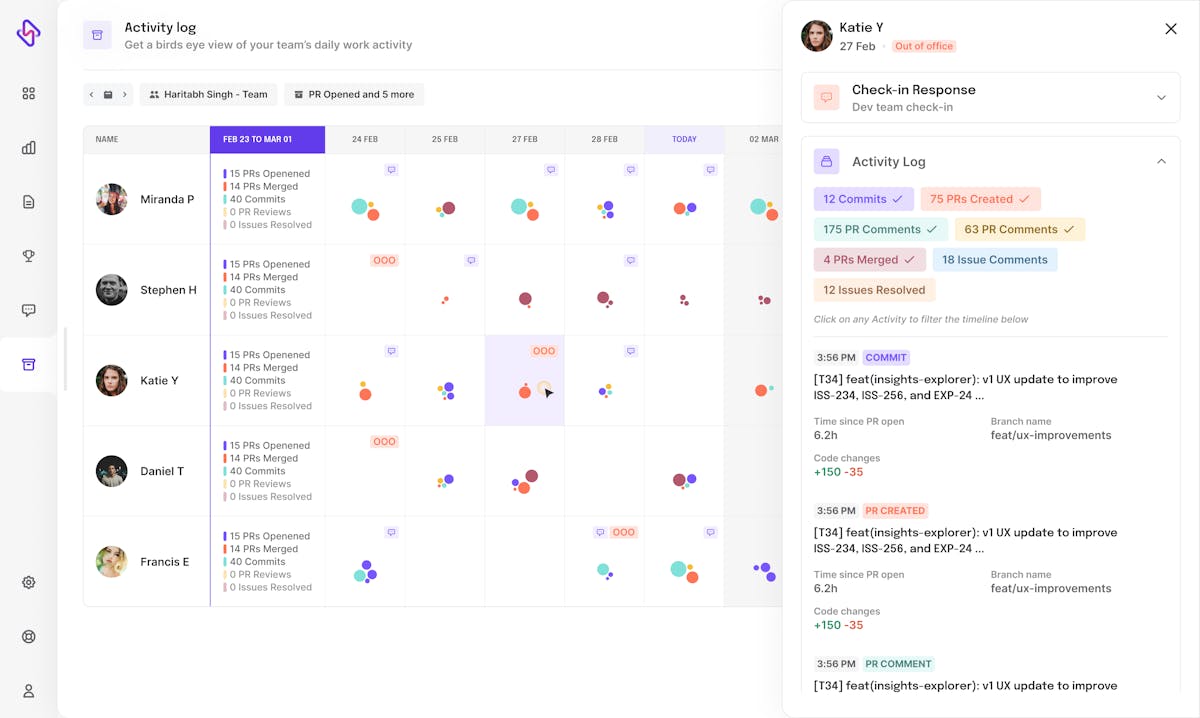
When team members are fully enrolled into each other’s work, meetings become more than just status updates.
With a single source of truth, teams have high workflow visibility, understand bottlenecks, and reduce frictions or communications debts owing to poor understanding of each other’s work.
That way meetings become more action-oriented, agenda-driven, and ends with concrete results, than meaningless discussions.
2. Have a Meeting Agenda
Data without context, and meetings without agenda do more harm than good to engineering teams. Data is useless if teams lack clarity on the direction they want to pivot in. Similarly, meetings without agenda are just random discussions with no purpose, direction, or concrete plan of action.
Sheryl Sanberg, Meta’s ex-COO, has been very intentional in holding agenda-driven meetings. Her spiral notebook has a list of pointers to discuss, and create plans for. She ensures the meeting stays true to the agenda, and doesn’t turn into a one-person presentation, or off-topic discussions. As soon as each item is checked, she strikes off the page, and moves to the next. As Meta’s COO, she ensured none of her meetings stretch longer than an hour despite too many items on her list.
Devs know what is expected from them, leading to a more organized and productive discussion.
3. Record Status Updates Through Async Standups
Async standups empower devs to share, and update work status without disrupting their flow state. Moreover, async work helps teams to keep a check on each other without
Please keep in mind, async communications aren’t antithetic to general team syncups, rather they serve as a middle-path where teams stay updated without wasting their flow state on hour-long status update meetings.
Hatica check-ins equips engineering teams with workflow visibility, day to day action items, team pulse, and developer workload- all at a single glasspane.
Hatica integrates with a team’s VCS, issue tracker, and communication tools to give a 360 degree picture of an engineering team’s work. It also helps engineering managers with early interventions as and when bottlenecks occur.
Want to know more about async standups? Check out how to use Hatica check-ins for daily standups.
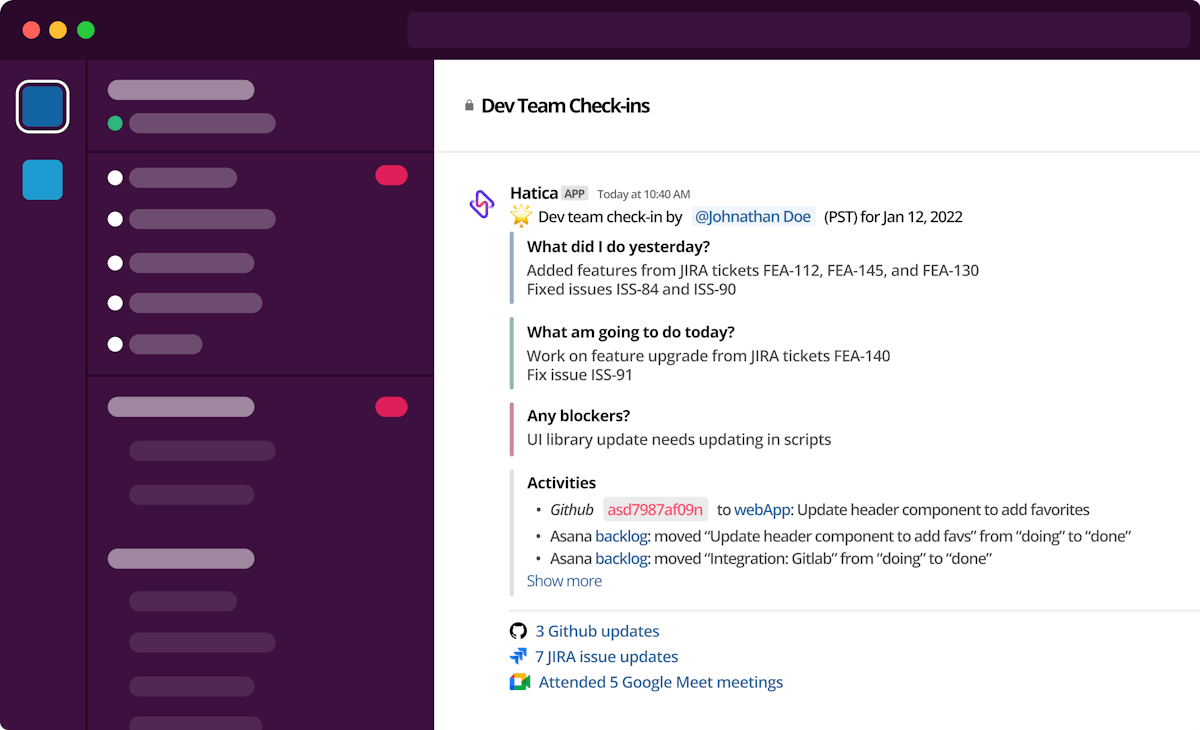
These async standups are agenda-driven, take a few minutes, and keep everyone informed about each other’s progress, so teams can have meaningful discussions later on.
4. Use Hatica’s Maker Time Dashboard
Hatica’s maker time is built in a way to reduce engineering distractions, so devs can have their uninterrupted flow state.
With data from the maker time dashboard, devs can configure their maker time hours, control time spent in meetings, and create a balance between all core communications: meetings, 1:1, and interviews.
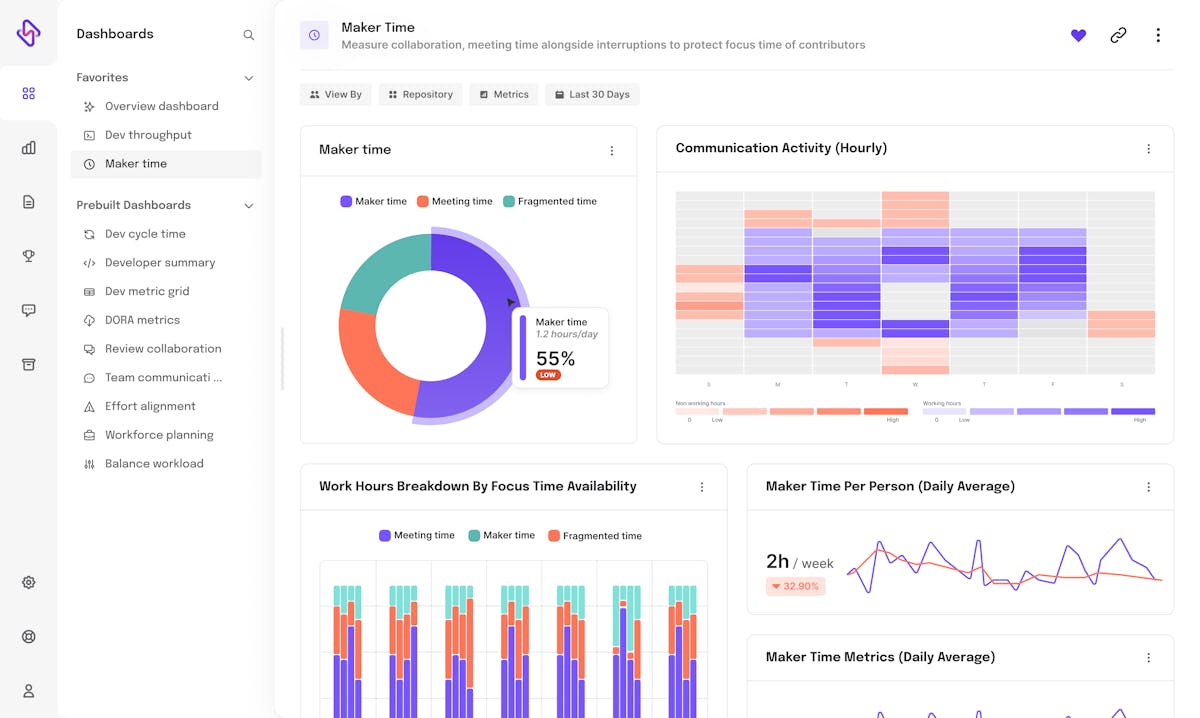
Moreover, EMs can create a maker time benchmark for each ICs. As soon as the line is breached, managers can take proactive steps to reduce distractions, help devs reschedule their meetings, and free up their workspace.
5. Consolidate Important Meetings
What’s worse than attending meetings? Our answer- Attending them throughout the day. Slack got so fedup with recurring meetings that they declared a calendar bankruptcy, removed all meetings from their calendar, and started from scratch. Since not everyone can afford the same luxury as Slack, the other way is to consolidate all your fragmented meetings. Most devs we know keep their second half free for meetings.
Again, using team data to understand an IC’s meeting hours is the key to reverse their fragmented schedule.
Hatica’s communication analytics help the engineering team to understand a team workday, their meeting schedule, and deep work hours.

With a transformative understanding of each other’s workday (with Hatica check-ins) teams can schedule meetings in one-go, reduce their fragmented time, and achieve deep work hours. Amenify, a Silicon Valley PropTech company used async standups, consolidated meetings, and increased their flow state by 10 more hours, using Hatica. Read about Amemify’s transformation.
With help of Hatica’s communication analytics, most users have been able to creating atleast two meeting-free days a week, and 30% less meetings (again, thanks to check-ins).
Hatica: Tackle Unproductive Meetings Head On!
Productive meetings have a ripple effect on engineering teams. They empower teams to find their flow state, improve developer productivity, and reduce the overall financial burden of an organization.
When used sustainably, meetings are a tool for change. They are a power reminder that every team is built on the pillars of effective communication, harmony, and shared vision. Powerful meetings plug feedback loops, keep projects on track, and bring team alignment.
With agenda-driven meetings, and data-backed communication, large engineering teams can save upto $1600 weekly! (remember, the meeting calculator!) Teams across the globe are adopting best meeting practices to empower developers, and offer teams autonomy to work. Shopify was able to save upto 15% of their overall operating expenditure, and 322,000 hours of manpower by culling down unproductive meetings.
Streamlining communications is the first step towards engineering success. Engineering teams use Hatica to cut on unnecessary meeting time, improve deep work hours, and reduce company costs caused by unproductive meetings.
Learn more about how to cut company costs, streamline meetings, and improve developer productivity with Hatica. Request a demo here→
FAQs
1. What Percentage of Meetings Are Unproductive?
As reported by the Harvard Business Review, a staggering 71% of meetings lack productivity.
2. What Are the Main Reasons for Meetings to Be Unproductive?
Lack of preparation is a key factor for unproductive meetings.
3. Are Too Many Meetings Unproductive?
Too many meetings not only impact team productivity but can also lead to the experience of Zoom fatigue.
Subscribe to Hatica's blog
Get bi-weekly insights straight to your inbox
- The Cost of Unproductive Meetings
- 4 Common Reasons Behind Unproductive Meetings
- 1. Lack of Data-Driven Conversations
- 2. ‘Too Long’ Meetings
- 3. Lack of Structured, and Planned Meetings
- 4. More Status Updates, and Less Meaningful Discussions
- How Unproductive Meetings Kill Developer Productivity?
- 1. Less Development Time For Engineers
- 2. Disrupted Flow State, and Maker Time
- 3. Frequent Context Switching
- 4. Poor Developer Experience
- Fixing The Meeting Madness At Work in 5 Easy Steps
- 1. Use Data to Drive 1:1s and Team Meetings
- 2. Have a Meeting Agenda
- 3. Record Status Updates Through Async Standups
- 4. Use Hatica’s Maker Time Dashboard
- 5. Consolidate Important Meetings
- Hatica: Tackle Unproductive Meetings Head On!
- FAQs
- 1. What Percentage of Meetings Are Unproductive?
- 2. What Are the Main Reasons for Meetings to Be Unproductive?
- 3. Are Too Many Meetings Unproductive?





